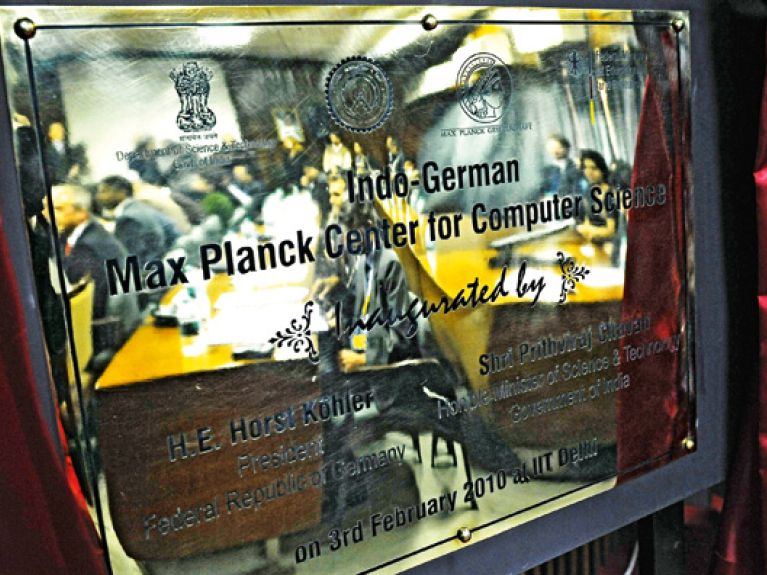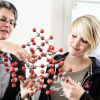Industry also plays an active role
Practical projects dominate Indo-German research cooperation. All the threads come together in Gurgaon and New Delhi.

When it comes to scientific and technological cooperation, India is Germany’s most important partner in South Asia. The Indo-German Science and Technology Centre (IGSTC), which opened in 2010, represents a milestone in research cooperation between the two countries. What kinds of biotechnological approaches can be applied to improve chickpea harvests? How can protection mechanisms in high-altitude plants be transferred to agricultural crops? Researchers from Germany and India examine questions like these in close cooperation with partners from industry. Based in Gurgaon near Delhi, the IGSTC supports innovative application-oriented Indo-German projects. Outstanding research institutions and companies from both countries are involved. The partners here include not only various Fraunhofer institutes, Forschungszentrum Jülich, RWTH University Aachen and Goethe University Frankfurt, but also the Institute of Himalayan Bioresource Technology, the ICRISAT research facility in Hyderabad and the Indian Institute of Technology Madras in Chennai.
The IGSTC sponsors research and development projects that closely network research and industry in so-called 2+2 projects, which include representation from two research partners each from science and industry. The Federal Ministry of Education and Research (BMBF) and the Department of Science and Technology (DST) provide up to two million euros a year for this purpose. The IGSTC primarily aims to strengthen bilateral cooperation in applied research and also to act as a catalyst. „IGSTC seeks new horizons to bring together the immense scientific talent in both countries to work together and resolve immediate and future S&T challenges”, explained Director Arunashis Chakraborty in his first annual report. The former Attaché for Science and Technology at the Indian Embassy in Berlin can see great opportunities.
The IGSTC is currently funding eleven projects. Major emphases here lie on collaboration in the fields of biotechnology, information technology, environmental and sustainability research, materials research, production technology and security research. Ideally, the project phase ends with a prototype that can be accepted and then improved by businesses. One example here is the compact linear Fresnel reflector (CLFR), a low-cost collector that can harvest heat for industrial production processes and was developed for the Indian market. “Solar energy is a big topic in India,” says Dr Anna Heimsath, who was in charge of the project at Fraunhofer ISE in Freiburg. “Working with colleagues at the Indian Institute of Technology in Bombay, we developed a design that did not only take into account local conditions and production costs, but also optical and thermal aspects.” The Thermax company in Pune then realised a prototype, while the German partner Schott Solar contributed receiver tubes and advice. It is now planned to integrate a demonstration installation in an existing power plant and use it to extract auxiliary heat.
The Department of Science and Technology (DST) is one of the largest and most important partners in India for German research organisations such as the German Research Foundation (DFG). The DFG is Europe’s largest research funding organisation. In India it has been represented by an office in New Delhi since 2006. A branch office in Hyderabad also focuses on the especially active research centres in South India. DFG-funded research partnerships cover a broad range of subjects – from research into historical documents to agricultural biology. Close contacts also exist in the social sciences and the humanities. One visible result of many years of cooperation is a first bilateral Indo-German agreement on the funding of cooperation in the social sciences between the DFG and the Indian Council for Social Sciences Research (ICSSR). On the other hand, a workshop for historians initiated by the DFG in 2012 laid the foundation stone for projects in the humanities with the Indian Council for Historical Research (ICHR). In the future, Indian researchers are also to take part in the German Historians’ Convention, which is one of largest gatherings of humanities scholars in Europe.
Research and funding organisations pool their resources in the German House for Research and Innovation (DWIH) in New Delhi, which opened in 2012. The consortium consists of 15 partners and is coordinated by the DFG. Not only research funding organisations, such as the Humboldt Foundation (AvH), the Fraunhofer-Gesellschaft (FhG), the German Academic Exchange Service (DAAD) and the Max Planck Society (MPG), are represented, but also industry – for example, the Indo-German Chamber of Commerce, the Deutsche Gesellschaft für Internationale Zusammenarbeit (GIZ) and the Bavarian-Indian Centre for Business and University Cooperation (BayIND) – and the research centres of various German universities. Conceived by the Federal Foreign Office, the DWIH serves as a “one stop shop” for interested students, researchers and research organisations offering an information platform about research and science in Germany and a forum where the German and Indian research community can prepare and realise joint projects. The DWIH New Delhi aims to be broad in scope and reach the largest possible geographical area. This is achieved, for example, by programmes of events like Excellence on Tour. The breadth of the German research landscape was presented to an interested specialist audience and the Indian general public in Hyderabad, Ahmedabad and Kolkata as part of a series of exhibitions, lectures and other networking events.

